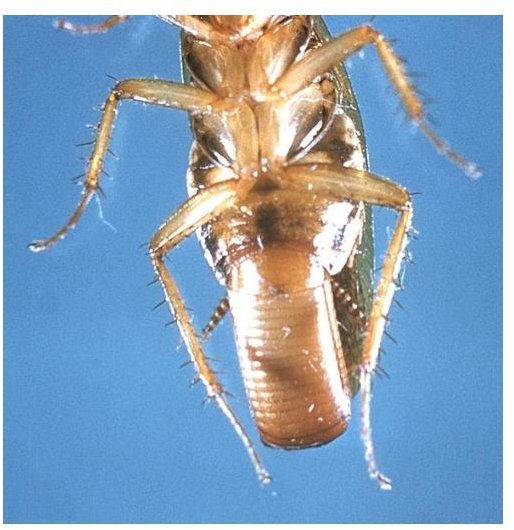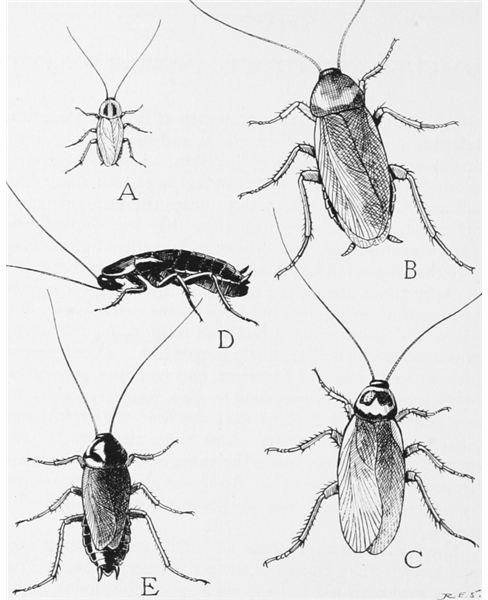Cockroach Fun Facts & Interesting Information
The Cockroach
Cockroaches (or roaches) have been around longer than humans. It is believed that they have been roaming the earth for 350 million years. There are roughly 4,000 species ranging in size, shape, and color. They live around the world and prefer warm conditions. Only a very few species (about 25) live in human habitations and are considered pests. Despite being disgusting creatures (by many), there are many interesting cockroach fun facts.
Above image of Common Household Roaches: A - German roach B - American cockroach C - Australian cockroach D - Oriental roach (wingless female) E - Oriental roach (winged male). Click on images to enlarge.
Description & Anatomy

Not all cockroaches are dirty-brown in color. Some are brightly colored, including the colors yellow, red, and green. Unlike humans, the cockroach’s skeleton is outside of the body (exoskeleton). As they outgrow their skeleton, they shed it (giving them a white appearance) and regrow a new one within a few hours (regaining their color).
The average cockroach is about 1/2 inch long and the largest is about 4 inches long. Typically, roaches have 6 hairy legs and 18 knees. They breathe through the sides of their bodies and, because cockroaches do not use hemoglobin to carry oxygen, the color of their blood is colorless (the blood of females producing eggs is slightly orange in color).
Headless Cockroaches
One really fun fact about roaches is how long they can live without their heads. Because they do not breathe from their heads (nose), they do not have blood pressure like a mammal (which can lead to uncontrolled bleeding), and they can go without water or food for a long period, the cockroach can live about a week or longer without its head. It eventually dies of dehydration.
Activity
Cockroaches are lazy. They spend about 75% of their day resting and are most active at night. However, they have quick reflexes and are the fastest insects on earth. They can run at speeds of nearly 2 mph. The cockroach can also swim and is able to hold its breath for up to 40 minutes.
Diet
The cockroach chews sideways and will eat just about anything, including food (preferably starchy foods and meats), dead insects (including other roaches), hair, paper, glue, clothes, cigarette butts, feces, the skin they shed, and their eggs.
Eggs

On average, about 1 week after mating, females produce 1 egg case (called an ootheca) about once a month. Each case contains approximately 14-16 eggs. She may carry the eggs until they hatch or she may hide them in a protected area (preferably near a source of food) by simply dropping the ootheca or by gluing it (with a secretion from her mouth) to a surface.
Advantages of Cockroaches
Many animals (including small mammals, amphibians, and birds) eat cockroaches and, believe it or not, they are also used by some for medicinal purposes. For centuries, they have been used to cure illnesses, including indigestion and dropsy (edema). Some people apply crushed roaches to stinging wounds to relieve pain.
More Information
More cockroach fun facts:
• Females release a chemical (“perfume”) called pheromones to attract males.
• Many cockroaches are able to fly.
• Many can squeeze through incredibly thin cracks.
• The cockroach is able to climb walls because of little claws on their feet.
• Depending on the species, some live for only a few months while others can live about 2 years.
References
The Cockroach FAQ: https://www.bio.umass.edu/biology/kunkel/cockroach_faq.html#Q16
Roach Facts: https://www.roachcom.net/rofacts/
Image Sources
Species image courtesy of the United States Department of Agriculture (in the public domain).
Ecdysis image courtesy of https://en.wikipedia.org/wiki/File:Ecdysis.jpg (image in the public domain).
Ootheca image courtesy of the Center of Disease Control (image in the public domain).
